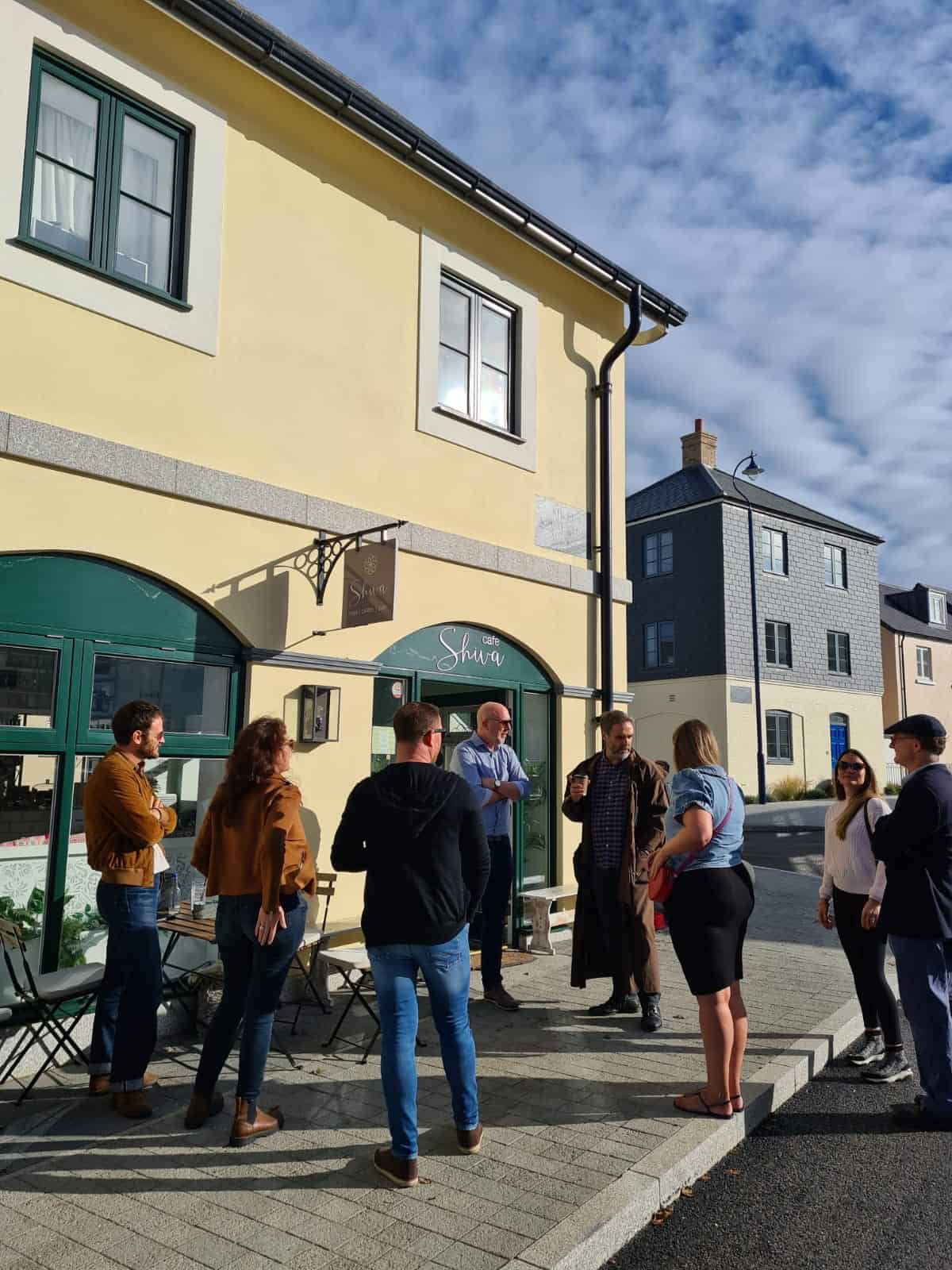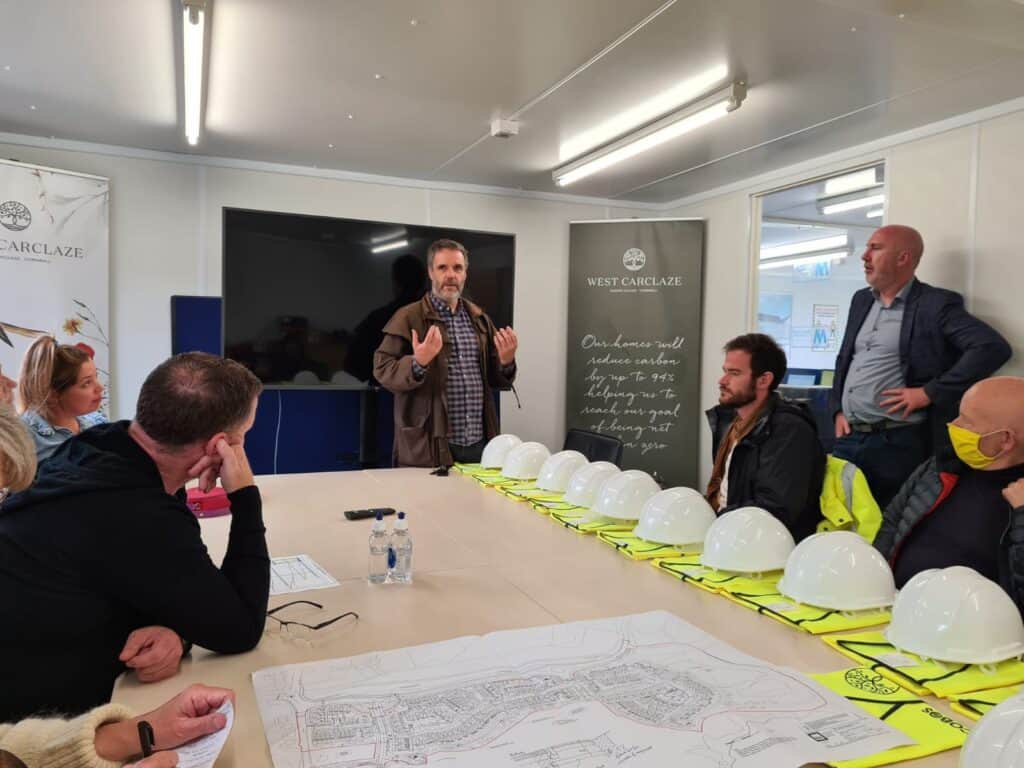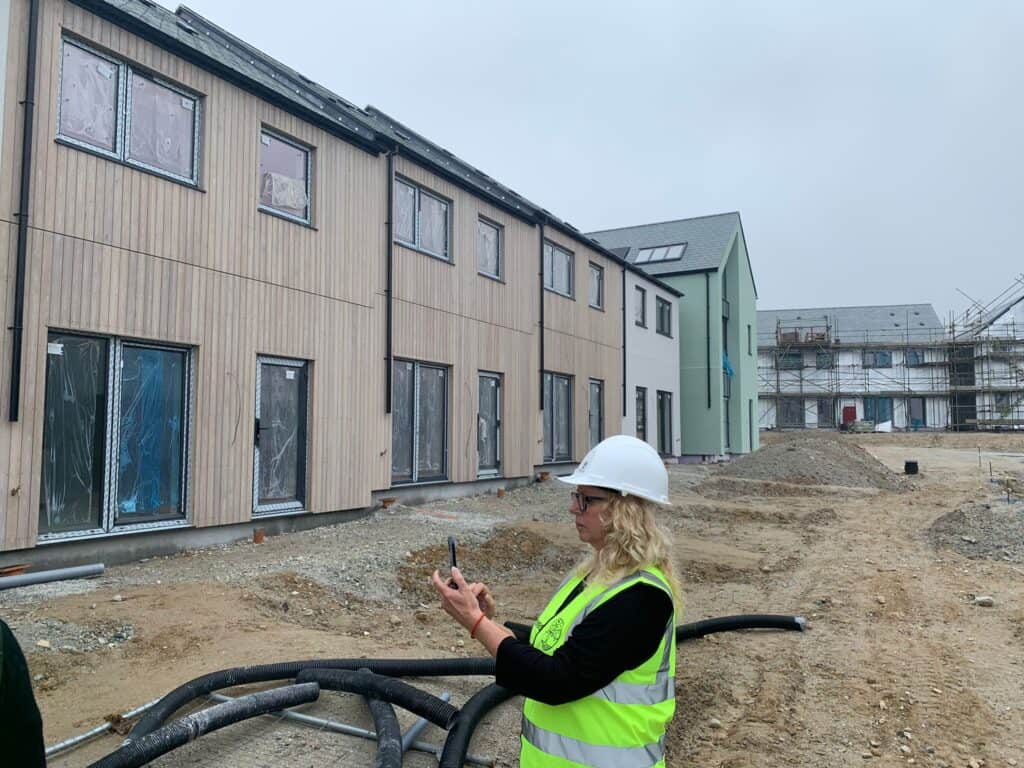Aymara Lamche-Brennan talks about LDN Collective’s first ever study trip, to Nansledan and West Carclaze in Cornwall.
“We were delighted to be invited by Lord Matthew Taylor (author of the Taylor Review of Planning and the Policy Exchange report on Garden Villages) for a walking tour of two very different new developments in Cornwall: Nansledan, a traditionally designed and sustainable urban extension of 4,000 homes east of Newquay and West Carclaze, a 1,500 home Garden Village in Cornwall’s Clay Country, north of St Austell.
On a bright Autumnal morning our group of 10 gathered at Shiva Cafe, a cafe-come-yoga space in the heart of the early phases of Nansledan, where 500 homes are currently occupied. Our group included urban designers, architects, transport planners, experts in health and food, modern methods of construction and community engagement bringing a wide array of perspectives. The cafe immediately presented a ‘popular with locals’ vibe with parents sitting outside, babies on laps and dogs on leads lapping up water. There was a definitive ‘buzz’ about the place.
We awaited the arrival of the good Lord who appeared in a distinctive brown riding coat, tails flapping in the breeze. After introductions over coffee, Matthew gave a fascinating and insightful overview as we listened intently, asking questions and looking about the place observing details from street names carved into local Delabole slate in the Cornish language, building heights, fenestration and surface materials. Oh the joys of the built environment where a wide range of stimulating visual information is processed in the time it takes to sip a coffee!

Setting off on our walking tour, it was clear to see how much attention had been paid to making Nansledan a memorable and distinctive place, with landmark buildings and spaces aiding orientation and wayfinding. A clear contrast to many new developments, where the monotony of streets and buildings can lead to ‘unsavoury suburbia’. The presence of fruit trees, defensible space, green frontages and planted edges work hard to soften the otherwise urban feel of the place.

As we turned from public space to residential street, the hierarchy of streets and spaces became reassuringly evident. Vistas were appropriately terminated by attractive buildings and long views out to rolling countryside were framed ingeniously by the introduction of local Cornish stone, to distinguish from the pastel-coloured render or brick facades.
The earthy, reddish-brown quality of the local stone draws the eyes attention, complimented by the vibrant green beyond, making for a welcome interlude to the lighter shades of the development. All of these design moves contribute layers of detail that helps to create character.

After a few residential streets we came upon the (yet to be completed) High Street where, to my surprise, another Cafe – The Ladyvale Bakery and Cafe – was packed to the rafters. Then, to my further surprise, at the top end of the High Street a third cafe, The Little Cornish Pantry, was also alive with the throng of people wanting a taste ‘the best of the West’.
It was strange to see so many people inhabiting a handful of public spots after walking through largely empty streets along the way, almost as if these cafes had dropped down to earth from another dimension. But then a local woman serving us pasties recognised Matthew and thanked him for being a great MP, complimenting him on all the hard work he had done for local people, and I was reminded that this really is an earthly place from the 21st Century.

Matthew then led our convoy to the Duchy’s farmhouse a short drive away for a workshop with Peter James, the Project Manager. I recognised Peter from the tour he had given me of Poundbury a few years ago and remember his enthusiasm then, which hadn’t waned. One of the most memorable lessons from Poundbury for me was to do with quality control and ensuring that each developer knew what the other was building so that the components of the place made a coherent whole, rather than a fragmented jigsaw that didn’t quite fit. This is noticeable in the middle phases of Poundbury where the excitement of the early days got the better of the development – quickly corrected to rescue the later phases from a similar fate.
Peter was impressed to hear the professional variety and expertise of the LDN cohort around the table and, after each person introduced themselves, he connected with that individual by relaying a brief anecdote relevant to their area of expertise, before moving on to the next introduction. It was nourishing for everyone in that board room.

Next stop, West Carclaze. A juxtaposition if ever there was one. Although still very much a construction site, the vision for West Carclaze is to create the best place to live in the UK, ‘where everyone can share the best of life in the West Country’. Constructed on old clay pits, the groundwork teams have faced huge challenges, discovering literal quicksand as excavation began. Despite this, the team on site are clearly driving the scheme forward with great enthusiasm and good spiritedness.
Barry, the site Director, took us through the early phases of the masterplan before getting us kitted out with protective equipment. Views, views and more incredible views was the first impression. Whatever does spring up here it will be nestled in a truly beautiful landscape, the Cornish mizzle (mist and drizzle) only adding to its charm.

Fondly known as The Sky Tip and composed of spoil from the china clay pits, a mountainous green hill looms in the distance. The locals were so connected to its presence and important cultural heritage as a prominent land and sea mark of St Austell, they managed to persuade UNESCO to extend the existing local World Heritage Status to embrace the Sky Tip, and rightly so!
Beyond its setting, it is impossible to comment on the character of the place as only the first 12 houses have been constructed. What I can say is that the buildings themselves are spacious and airy with lots of natural light, they are arranged nicely and appear to compliment each other even at this early stage.

We travelled to another area on the edge of a lake where construction has not yet begun, a truly remarkable sight. Opaque white water from the clay deposits, surrounded by jurassic looking ferns and wild purple heather. Soon houses will be built here overlooking this fantastical scenery. If West Carclaze evolves to be everything it promises, then you can sign me up for a lakeside home here.
At the current time, however, its the landscape that steals the show at West Carclaze and this should remain true even with the highest quality buildings being completed in the years to come. It is the spaces between buildings that give us the vibrancy of life that we so desperately crave as living, breathing, moving human beings.

Here is a testimonial from Lord Matthew Taylor, Author of UK Garden Community Policies. Please do get in touch if you would like us to offer similar support.

All in all, what a brilliant way to spend two days down in Cornwall. We even managed a swim in the sea on the last morning. Thank you to Max Farrell for organising the trip and Lord Matthew Taylor for being a wonderful host, tour guide, and dinner companion.”








